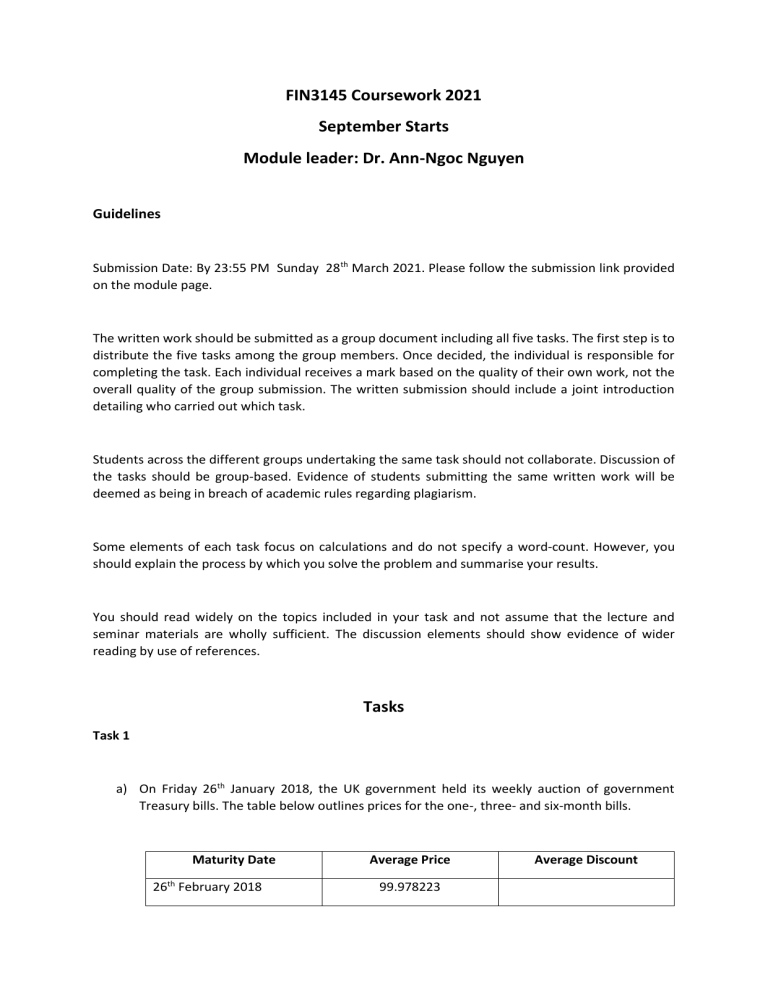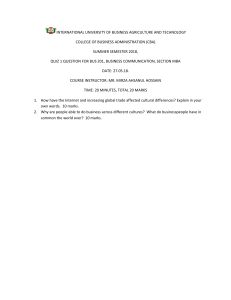
FIN3145 Coursework 2021 September Starts Module leader: Dr. Ann-Ngoc Nguyen Guidelines Submission Date: By 23:55 PM Sunday 28th March 2021. Please follow the submission link provided on the module page. The written work should be submitted as a group document including all five tasks. The first step is to distribute the five tasks among the group members. Once decided, the individual is responsible for completing the task. Each individual receives a mark based on the quality of their own work, not the overall quality of the group submission. The written submission should include a joint introduction detailing who carried out which task. Students across the different groups undertaking the same task should not collaborate. Discussion of the tasks should be group-based. Evidence of students submitting the same written work will be deemed as being in breach of academic rules regarding plagiarism. Some elements of each task focus on calculations and do not specify a word-count. However, you should explain the process by which you solve the problem and summarise your results. You should read widely on the topics included in your task and not assume that the lecture and seminar materials are wholly sufficient. The discussion elements should show evidence of wider reading by use of references. Tasks Task 1 a) On Friday 26th January 2018, the UK government held its weekly auction of government Treasury bills. The table below outlines prices for the one-, three- and six-month bills. Maturity Date 26th February 2018 Average Price 99.978223 Average Discount 30th April 2018 99.940167 30th July 2018 99.779994 Calculate the discount rates for the three bills. You must show the price using an appropriate mathematical formulation and take into account the difference between the auction date and settlement date when working out the terms to maturity. (30 marks) b) The table below lists the principal amounts of each bill auctioned and the scale of bidding on 26th January 2018. Maturity Date Principal Amount Sold Aggregate Scale of Bids 26th February 2018 £500 million £2711.5 million 30th April 2018 £500 million £2869.0 million 30th July 2018 £2000 million £6134.5 million Calculate and comment on the significance of the bid-to-cover ratios given the size of the yields. The word-count for this element should be 200-300 words. (30 marks) c) Choose a Debt Management Office treasury bill auction between 2005 and 2007 and compare the scale of the discount rates with those form the 26th January 2018 auction. The discussion should focus on the difference between the earlier and recent discount rates, and provide reasons why they are so different. Make sure that you clearly record and reference the earlier data. The word count for this element should be 300-400 words. (40 marks) (Total marks 100) Task 2 A company operates a commercial paper programme to finance its short-term US dollar-denominated borrowing requirements. On 26th January 2018, the company sold paper with terms to maturity of 30 days, 182 days and 270 days. The table below lists US treasury bill yields and the basis point premiums over treasury yields being offered by each issue of commercial paper. Days to Maturity Treasury Bill Discount Rate Basis Point Premium 30 days 1.4106% 40 basis points 182 days 1.6422% 71 basis points 270 days 1.7642% 85 basis points a) Calculate the annualised discount rates and prices for the three commercial paper issues. Your mathematical workings should be clearly outlined in your written presentation. For valuation purposes, assume a 360-day year. (30 marks) b) The commercial paper was given a P-2 rating by Moody’s and an A-2 rating by Standard & Poor. Outline the ratings systems used by Moody’s and Standard & Poor for grading shortterm debt securities and explain the significance of the ratings given to the company’s commercial paper. The word-count for this element should be 300-400 words. (40 marks) c) With reference to the data on the company’s commercial paper yields, discuss the following questions: 1. Why do short-term debt securities issued by private companies generally offer higher yields than treasury bills issued by central governments? 2. Why is the size of the basis point premium larger the longer the term to maturity? The word count for this element should be 200-300 words. (30 marks) (Total marks 100) Task 3 A company is due to receive €2,500,000 two-months from today and wishes to save the funds for three months. Money market interest rate spreads for short-term euro transactions are presented in the table below. Money Market Dollar Interest Rate Spreads (%) 1 month 2 months 3 months 4 months 5 months 6 months 0.20 - 0.25 0.28– 0.33 0.35 – 0.40 0.45 – 0.56 0.60 – 0.67 0.75 – 0.83 a) Assume that the company wishes to undertake a money market hedge to fix the future deposit rate. Explain the character of the company’s interest rate risk exposure and calculate the annualised forward interest rate that it can achieve using the current interest rates. Base calculations on months rather than days and clearly outline the mathematical workings in your written presentation. The word-count for this element should be 150-250 words. (40 marks) b) A bank is willing to offer the company a forward rate agreement (FRA), incorporating a forward rate fixed at the level calculated in part a). When the money is received, the €LIBOR rate is 0.35%. Calculate and explain the terms on which the FRA is settled. Clearly outline the mathematical workings in your written presentation. (30 marks) c) Given the forward rate available to the company, discuss the factors that it should consider at the outset when deciding whether to fix the future interest rate. The word count for this element should be 200-300 words. (30 marks) (Total marks 100) Task 4 The table below lists the terms to maturity, the coupon rates, coupon payment dates and yields to maturity for three UK government bonds at the close of business on 7th January 2018. Gilts Prices Close of Business 7th January 2018 Maturity Date Coupon Rate Coupon Payment Dates Yield to Maturity 07/04/2022 3.75% 7th April, 7th October 0.784735 20/08/2027 1.70% 20th February, 20th August 1.394042 07/06/2035 4.00% 7th June, 7th December 1.868424 The coupon rates are quoted as annual rates. But UK government bonds divide the annual coupon into two equal instalments payable every six months. a) Work out the time periods to maturity, the periodic coupons and the periodic yields for each of the three bonds. Use the information to calculate the clean price of each bond. Your mathematical workings should be clearly outlined in your written presentation. (40 marks) b) Calculate the accrued interest and dirty prices for each bond at the close of business on 7 th January 2018. Your mathematical workings should be clearly outlined in your written presentation. (25 marks) c) UK government bonds are widely considered to be risk-free investments. Explain what is meant by ‘risk-free’ in this context and discuss the notion that they are, nevertheless, exposed to market risk. The word count for this element should be 250-350 words. (35 marks) (Total marks 100) Task 5 a) A company has issued $75 million (face value) of bonds with three-years to maturity. They offer an annual coupon of 2.46% above the sixth-month $LIBOR. Interest is paid every six months and the $LIBOR is currently 0.78%. Assume that the $LIBORs for the subsequent five interest set dates are as stated in the table below. $LIBOR Rates 0.5 years 1 year 1.5 years 2 years 2.5 years 0.88% 1.47% 2.68% 3.28% 4.50% Calculate the coupon rate and the amount of interest that the company pays at the end of each six-month period. Your mathematical workings should be clearly outlined in your written presentation. (25 marks) b) A company has issued five-year bonds with the annual coupon and the repayment of principal linked to an index of inflation. The coupon rate is 4.75% and the principal is £100. The index of inflation is currently set at 100. Assume annual inflation rates for the next five years in the table below. Inflation Rate Year 1 Year 2 Year 3 Year 4 Year 5 0.88% 1.47% 2.68% 3.28% 4.50% Calculate the level of the inflation index for each year and use it to determine the coupon payment per bond for each of the five years. In addition, calculate the amount that the company pays bondholders when the debt matures after five years. Your mathematical workings should be clearly outlined in your written presentation. (30 marks) c) Explain the main characteristics of variable coupon and index-linked bonds. Discuss how they help to off-set some of the risks faced by investors in plain vanilla fixed interest securities. The discussion should include an assessment of the limitations of variable coupon and index-linked securities as assets offering protection against certain types of risk. The word count for this element should be 350-450 words (45 marks) (Total marks 100)





